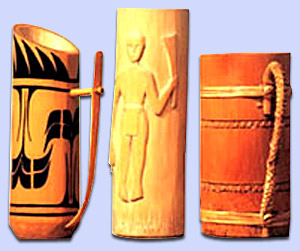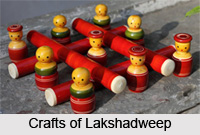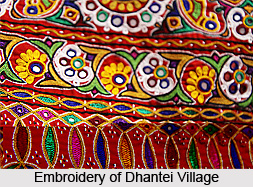 Applique comes from the French word applique, which means to "put on". It involves the art of decorating a cloth using glass pieces, metals pieces, wood, gemstones, cloth pieces etc. Applique with fabrics involves placing one layer of fabric over another and sewing it in place. Metals, glass pieces or gemstones are also stitched on the fabric in the same way. Applique is mostly practiced in the western states of India like Rajasthan and Gujarat, in the eastern coast of Orissa, Punjab and Bihar. It has provided some of the most beautiful Indian fabric art including bed spreads, lampshades, wall hangings and many more. Among the traditional textiles, the art of Applique work occupies a distinguished place.
Applique comes from the French word applique, which means to "put on". It involves the art of decorating a cloth using glass pieces, metals pieces, wood, gemstones, cloth pieces etc. Applique with fabrics involves placing one layer of fabric over another and sewing it in place. Metals, glass pieces or gemstones are also stitched on the fabric in the same way. Applique is mostly practiced in the western states of India like Rajasthan and Gujarat, in the eastern coast of Orissa, Punjab and Bihar. It has provided some of the most beautiful Indian fabric art including bed spreads, lampshades, wall hangings and many more. Among the traditional textiles, the art of Applique work occupies a distinguished place.
Origin of Applique
The roots of Applique art are intertwined with the rituals and traditions of Lord Jagannath, the presiding deity of the Puri temple. Applique items were mainly used during processions of the deities in their various ritual outings. Applique was traditionally practised by a caste of professional tailors, known as `Darjis`. This art was initially an integral part of the folk art of Gujarat. In ancient times, articles produced by this craft were prevalent among kings and emperors. `Shamiana` and `chandowa` were the two principal items of this craft which are still in use for all religious and social ceremonies.
 Technique of Applique
Technique of Applique
Applique is a technique in which patches of coloured fabrics are superposed on a plain basic fabric. Patches of different motifs are cut out from clothes. For multiple patches of same design, stencils are used. These patches are then stitched on the base cloth in predetermined layouts and sequences. Edges of the patches are sewn beautifully. Sometimes small pieces of fabrics are stitched together, side by side, to form larger designs or to repair damages. While sewing, the edges of the motifs are turned in and are skilfully stitched over the base cloth. The edges are sometimes sewn simply with exclusive embroideries, without turning them in. The patches are also decorated with beautiful embroideries and mirror works. Different types of embroideries used in Applique work are bakhia, taropa, ganthi, chikana, button-hole, and ruching.
Motifs in Applique Art
Originally the art of Applique hovered around the temples and its festivals in the form of large and decorated umbrellas, tents and pavilions. However, nowadays these also find their utility in beach and garden umbrellas, lampshades, canopies for parties and public gatherings. The motifs used in Applique work are generally stylised representations of flora and fauna as well as a few mythical figures. Various designs used in this art are elephants, parrots, peacocks, ducks, creepers, trees, flowers, celestial structures and many more. Vibrantly coloured motifs include peacocks with their tails unfurled, elephants with a rider, or a horse carrying a warrior, in addition to floral patterns. The Applique work of Bihar, also known as khatwa, is well known for decorative tents and canopies used for ceremonial occasions. The designs on tents are the usual Persian type trees, flowers, animals, birds etc. The kanatas carry stylised forms of trees with juxtaposed animals at the base.
 Applique Work in Gujarat
Applique Work in Gujarat
Gujarat applique is mainly based on patchwork in which coloured and patterned fabrics are finely cut out in different sizes and shapes. These are sewn together on a plain background to form a composite structure. The whole charm of Applique lies in the contours of each individual inset piece. The stitches done on each individual bit are not always hidden. They often enhance the beauty of this art. In fact, threads of gaudy colours are usually used to make them more prominent.
Applique Work in Bihar
Applique work is extensively practiced by the women of Bihar. It is an interesting legacy of olden times when a variety of kanatas, shamianas, canopies and tents, with different types of brocades and patch-works were prepared. Even in today`s world, the shamianas with Applique work are a fashion. The designs and motifs generally prepared on the kanatas require pieces of the clothes stitched on a basic material with a few rough stitches. The base clothes are generally of dark hues and motifs of contrasting colours are stitched on them. Joining of colourful clothes together is also a common practice in the making of shamianas. Gorgeous shamianas are the manifestations of combined efforts of the craftsmen where men cut out the patterns to be stitched and women are engaged in the entire stitching. Applique is also practiced on garments. Energy and passion seem to find expression through the vibrant hues which provide the key to the mood and the tempo of Applique work.
Applique art can be traced on a range of artefacts including traditional umbrellas, canopies, saris, cholis, household linen, tents and pavilions, beach and garden umbrellas, lampshades, shoulder bags, wall hangings, bed covers, pillow covers, letter pouches, torans, chaklas, shamiana, chandowa, cushion-cover, curtains, tea cosies, table cloths, blouse pieces, sari borders and many more. Different artefacts of alluring designs furnished by the artisans of different parts of India attract people from all over the world.






